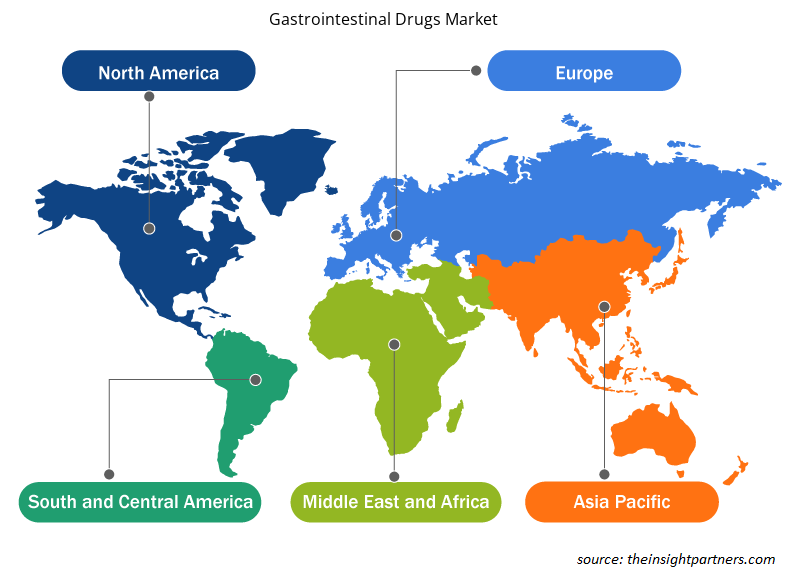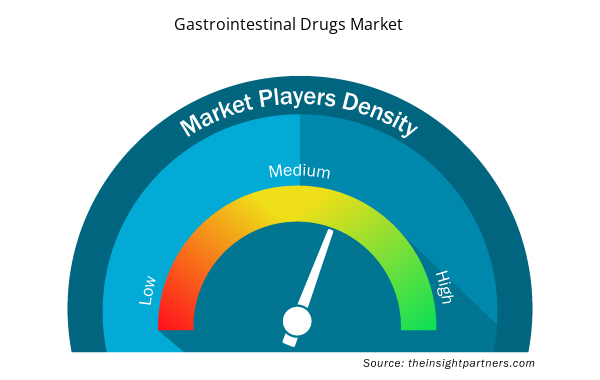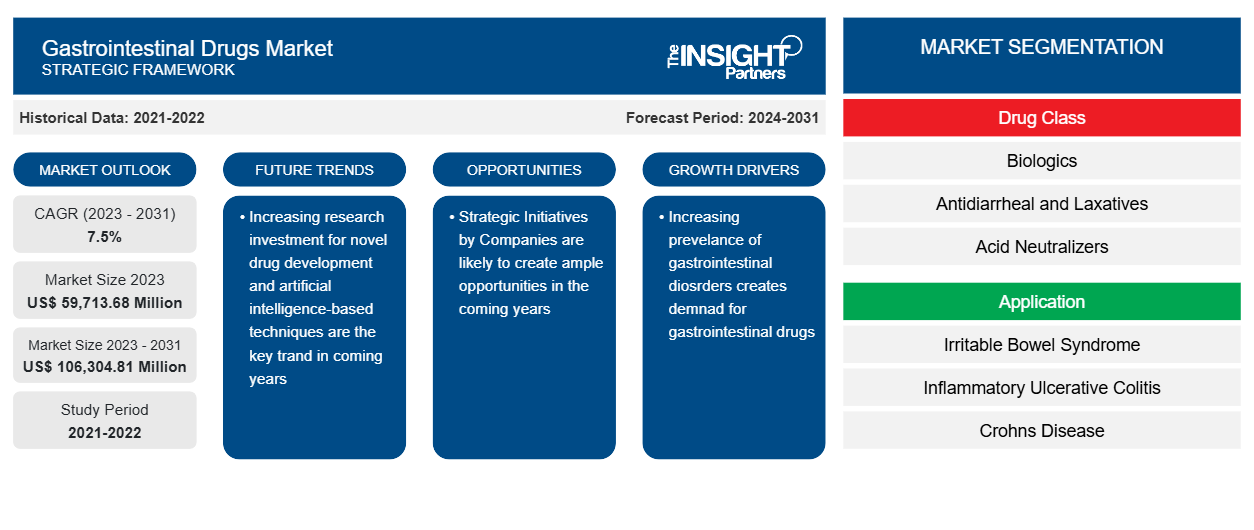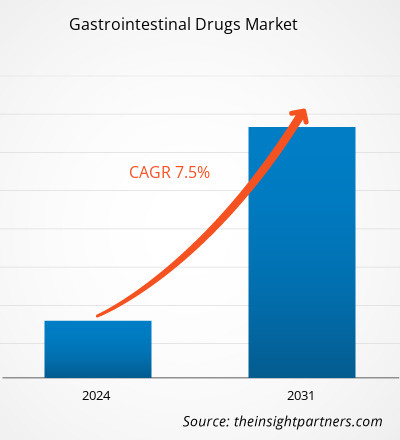预计到 2031 年,胃肠药物市场规模将从 2023 年的 597.1368 亿美元增至 1063.0481 亿美元。预计 2023-2031 年期间市场复合年增长率将达到 7.5%。未来几年,增加对新药开发和基于人工智能的技术的研究投资可能会为胃肠药物市场带来新趋势。
胃肠药物市场分析
推动胃肠道药物市场发展的因素包括各个年龄段慢性便秘病例的增加、非处方药销售的激增、对泻药的需求不断增长以及制造商的产品供应不断增加。制药公司正在投资研发,旨在创造新的、更有效的胃肠道药物。对生物制剂开发的投资不断增加以及生物仿制药的推出,推动了胃肠道药物市场的扩张。胃肠道药物的进步和改进导致了创新药物的诞生,这些药物可以提供更好的效果、更高的耐受性和更少的副作用。随着患者意识的提高,对能够有效控制症状和增强患者整体健康的药物的需求也越来越大。此外,最先进的医疗设施的存在和高额的医疗保健支出正在推动胃肠道药物市场的增长。
胃肠药物市场概况
市场增长归因于炎症性肠病 (IBD) 和肠易激综合征(IBS) 等胃肠道疾病的患病率不断上升,以及研发活动的激增,从而推动了用于治疗各种胃肠道疾病的先进疗法的创新。2021 年 4 月,Intract Pharma Limited 与 Ferring Pharmaceuticals 启动了一项合作研究计划,以研究针对未公开的白细胞介素的单克隆抗体 (mAb) 的口服给药以治疗 IBD。该研究重点评估 Intract 的 Phloral 和 Soteria 技术,以便将治疗性 mAb 直接精确口服给药至胃肠道组织,以提高疗效并最大限度地减少全身暴露。
英国不断开展的宣传活动提高了广大民众的认知度,并刺激了对治疗各种胃肠道疾病的胃肠道药物的需求。例如,武田制药与英国克罗恩病和结肠炎协会合作开发了“In My Shoes”应用程序,以提高人们对全国各地患有 IBD 的患者需要更持续护理的认识。
定制此报告以满足您的需求
您可以免费定制任何报告,包括本报告的部分内容、国家级分析、Excel 数据包,以及为初创企业和大学提供优惠和折扣
- 获取此报告的关键市场趋势。这个免费样品将包括数据分析,从市场趋势到估计和预测。
胃肠药物市场驱动因素和机遇
生物制剂发展改善有利于市场增长
过去几年,用于治疗炎症性疾病的先进新疗法(如生物制剂)的开发不断增加。此外,生物制剂已经改变了 IBD 的治疗,并在治疗这些疾病方面取得了成功,这支持了生物制剂在其他胃肠道疾病中的应用。生物制剂还可有效治疗嗜酸性食管炎、乳糜泻、自身免疫性肝炎和其他胃肠道疾病,因为它们针对的是免疫系统中的致病因素。许多溃疡性结肠炎药物对免疫系统有广泛的影响。为了阻止炎症过程的这种影响,生物制剂被广泛使用。一类用于治疗溃疡性结肠炎的生物药物被称为抗 TNF 药物,它可以阻断一种名为肿瘤坏死因子-α (TNF alpha) 的蛋白质。这种蛋白质会促进肠道和特定其他器官的炎症。抗 TNF 药物是首批获准用于治疗 IBD 的生物制剂,极大地改变了 IBD 管理。抗 TNF 药物包括 Humira、Simponi 和 Remicade。多种生物药物可以减轻成人 IBD 症状并帮助实现缓解。生物药物可以成为控制溃疡性结肠炎症状的有效替代品。FDA 已批准多种生物药物用于治疗克罗恩病和溃疡性结肠炎,例如 Humira(阿达木单抗)、Cimzia、Simponi(戈利木单抗)、Tysabri、Remicade(英夫利昔单抗)、Entyvio(维多珠单抗)和 Stelara(乌司他单抗)。
许多公司都参与开发各种生物药物。2020 年 7 月,武田制药在印度推出了生物药物 Vedolizumab,作为其胃肠道产品组合的一部分。Vedolizumab 在印度以 Kynteles 品牌销售。它用于治疗多种慢性 IBD。Vedolizumab 已成为治疗中度至重度克罗恩病和溃疡性结肠炎患者的二线生物制剂中的首选,这些患者使用传统药物或抗 TNF 药物治疗失败。2024 年 2 月,Celltrion Healthcare 的 Remsima SC 获得加拿大卫生部批准,用于 IBD 的维持治疗。随着发展中国家胃肠道疾病病例的增加,这些市场推出了新的生物制剂。因此,用于治疗胃肠道疾病的生物制剂的不断发展推动了胃肠道药物市场的发展。
企业的战略举措
胃肠药物市场中的公司不断关注战略发展,这有助于他们提高销售额、扩大地理覆盖范围并提高满足现有客户群需求的能力。以下是胃肠药物市场中主要参与者采取的一些战略举措:
• 2024 年 4 月 19 日,武田获得美国食品药品监督管理局 (FDA) 批准,以皮下注射 ENTYVIO(维多珠单抗)作为维持疗法,用于治疗患有轻度至重度活动性克罗恩病的成年人。FDA 还于 2023 年 9 月批准皮下注射同一种药物,用于治疗被诊断为中度至重度溃疡性结肠炎的成年人,该药物在美国以单剂量预充式注射笔的形式提供。
• 2023 年 10 月,礼来公司获得美国 FDA 批准 Omvoh (mirikizumab) 输注/注射剂,这是首个也是唯一一个用于治疗成人中度至重度溃疡性结肠炎的白细胞介素-23p19 (IL-23p19) 拮抗剂。与现有治疗方法不同,mirikizumab 还可以缓解严重影响患者生活质量的关键症状——排便紧迫感。
• 2023 年 9 月,Vivante Health 在由新投资者 Mercato Partners 领投的 B 轮融资中筹集了 3100 万美元,用于推进数字消化健康平台。新资金主要来自 GIThrive 平台的最新增强功能,这些功能凸显了该平台在适当时间提供适当护理的独特能力。B 轮融资提供持续的技术进步,旨在预测胃肠道疾病的发生和进展并提供完整的虚拟护理。
因此,各公司专注于开发治疗消化系统疾病的药物的战略举措可能会为未来几年胃肠药物市场的增长提供丰厚的机会。
胃肠药物市场报告细分分析
有助于得出胃肠药物市场分析的关键部分是药物类别、应用、给药途径和分销渠道。
- 根据药物类别,胃肠药物市场分为生物制剂、止泻药和泻药、酸中和剂、消炎药、止吐药和止吐药等。生物制剂部分在 2023 年占据了最大的市场份额。止吐药和止吐药部分预计将在 2023-2031 年期间在市场上实现最高的复合年增长率。
- 根据应用,胃肠药物市场分为肠易激综合征、炎症性溃疡性结肠炎、克罗恩病、胃肠炎、乳糜泻等。肠易激综合征部分在 2023 年占据了最大的市场份额。预计在 2023-2031 年期间,胃肠炎部分将在市场上实现最高的复合年增长率。
- 根据给药途径,市场分为口服和肠外给药。口服部分在 2023 年占据了更大的市场份额,预计在预测期内市场复合年增长率会更高。
- 就分销渠道而言,胃肠药市场分为医院药房、零售药房和在线药房。医院药房在 2023 年占据市场主导地位,预计在 2023-2031 年期间将实现最高复合年增长率。
胃肠药物市场份额(按地区)分析
胃肠药物市场报告的地理范围主要分为五个区域:北美、亚太、欧洲、中东和非洲、南美和中美。
2023 年,北美占据了相当大的市场份额。该地区市场的增长归因于胃肠道疾病发病率的上升以及政府和非政府组织对胃肠道治疗研究工作的支持。此外,众多市场参与者的参与以及他们采取的不同战略举措正在推动该地区市场的增长。此外,产品的易得性和患者意识的提高是促使北美市场扩张的其他几个因素。
胃肠药物市场区域洞察
Insight Partners 的分析师已详尽解释了预测期内影响胃肠药物市场的区域趋势和因素。本节还讨论了北美、欧洲、亚太地区、中东和非洲以及南美和中美洲的胃肠药物市场细分和地理位置。

- 获取胃肠药物市场的区域特定数据
胃肠药物市场报告范围
| 报告属性 | 细节 |
|---|---|
| 2023 年的市场规模 | 597.1368 亿美元 |
| 2031 年市场规模 | 1063.0481亿美元 |
| 全球复合年增长率(2023 - 2031) | 7.5% |
| 史料 | 2021-2022 |
| 预测期 | 2024-2031 |
| 涵盖的领域 | 按药物类别
|
| 覆盖地区和国家 | 北美
|
| 市场领导者和主要公司简介 |
|
胃肠药物市场参与者密度:了解其对业务动态的影响
胃肠药物市场正在快速增长,这得益于终端用户需求的不断增长,而这些需求又源于消费者偏好的不断变化、技术进步以及对产品优势的认识不断提高等因素。随着需求的增加,企业正在扩大其产品范围,进行创新以满足消费者的需求,并利用新兴趋势,从而进一步推动市场增长。
市场参与者密度是指在特定市场或行业内运营的企业或公司的分布情况。它表明在给定市场空间中,相对于其规模或总市场价值,有多少竞争对手(市场参与者)存在。
在胃肠药物市场运营的主要公司有:
- 赛诺菲公司
- 葛兰素史克公司
- 强生公司
- 博士伦保健公司
- 阿斯利康广场
- 武田药品工业株式会社
免责声明:上面列出的公司没有按照任何特定顺序排列。

- 了解胃肠药物市场的主要参与者概况
胃肠药物市场新闻及最新发展
胃肠药物市场通过收集一级和二级研究后的定性和定量数据进行评估,其中包括重要的公司出版物、协会数据和数据库。下面列出了胃肠药物市场的一些发展情况:
- 拜耳消费者保健公司向美国数百万患有肠道健康问题的人推出了一种植物性消化缓解产品 Iberogast。Iberogast 采用经临床验证的专有六种草本混合物配制而成,利用自然的力量,通过帮助缓解胃部不适和恢复消化功能,为偶尔出现消化症状的人提供双重缓解。(来源:拜耳股份公司,新闻稿,2024 年 4 月)
- AbbVie Inc. 和 Landos Biopharma, Inc. 达成最终协议,AbbVie 收购 Landos,后者是一家临床阶段生物制药公司,专注于为自身免疫性疾病患者开发新型口服疗法。Landos 的主要研究资产是 NX-13,这是一种具有双峰作用机制的首创口服 NLRX1 激动剂,具有抗炎和促进上皮修复的作用。(来源:AbbVie Inc.,新闻稿,2024 年 3 月)
胃肠药物市场报告覆盖范围和交付成果
“胃肠药物市场规模和预测(2021-2031)”报告对以下领域进行了详细的市场分析:
- 胃肠药物市场规模及全球、区域和国家层面所有主要细分市场的预测
- 胃肠药物市场趋势以及市场动态,如驱动因素、限制因素和关键机遇
- 详细的 PEST 和 SWOT 分析
- 胃肠药物市场分析涵盖主要市场趋势、全球和区域框架、主要参与者、法规和最新市场发展
- 行业格局和竞争分析,涵盖市场集中度、热点图分析、知名参与者以及胃肠药物市场的最新发展
- 详细的公司简介
- 历史分析(2 年)、基准年、预测(7 年)及复合年增长率
- PEST 和 SWOT 分析
- 市场规模价值/数量 - 全球、区域、国家
- 行业和竞争格局
- Excel 数据集


- Photo Editing Software Market
- Nitrogenous Fertilizer Market
- Hydrolyzed Collagen Market
- Microcatheters Market
- Batter and Breader Premixes Market
- Equipment Rental Software Market
- Lyophilization Services for Biopharmaceuticals Market
- Vision Care Market
- Aircraft Wire and Cable Market
- Data Annotation Tools Market

Report Coverage
Revenue forecast, Company Analysis, Industry landscape, Growth factors, and Trends

Segment Covered
This text is related
to segments covered.

Regional Scope
North America, Europe, Asia Pacific, Middle East & Africa, South & Central America

Country Scope
This text is related
to country scope.
常见问题
The global gastrointestinal drugs market is estimated to register a CAGR of 7.5% during the forecast period.
Sanofi SA, GSK Plc, Johnson & Johnson, Bausch Health Companies Inc, AstraZeneca Plc, Takeda Pharmaceutical Co Ltd, AbbVie Inc, Bayer AG, Pfizer Inc, and Celltrion Inc. are among the key players operating in the gastrointestinal drugs market.
North America dominated the gastrointestinal drugs market in 2023.
The rising incidence of gastrointestinal diseases and increasing development of biologics are the most influential factors responsible for the market growth.
The estimated value of the gastrointestinal drugs market can reach US$ 1,06,304.81 million by 2031.
Trends and growth analysis reports related to Life Sciences : READ MORE..
The List of Companies - Gastrointestinal Drugs Market
- Sanofi SA
- GSK Plc
- Johnson & Johnson
- Bausch Health Companies Inc
- AstraZeneca Plc
- Takeda Pharmaceutical Co Ltd
- AbbVie Inc
- Bayer AG
- Celltrion Inc
- Pfizer Inc
The Insight Partners performs research in 4 major stages: Data Collection & Secondary Research, Primary Research, Data Analysis and Data Triangulation & Final Review.
- Data Collection and Secondary Research:
As a market research and consulting firm operating from a decade, we have published and advised several client across the globe. First step for any study will start with an assessment of currently available data and insights from existing reports. Further, historical and current market information is collected from Investor Presentations, Annual Reports, SEC Filings, etc., and other information related to company’s performance and market positioning are gathered from Paid Databases (Factiva, Hoovers, and Reuters) and various other publications available in public domain.
Several associations trade associates, technical forums, institutes, societies and organization are accessed to gain technical as well as market related insights through their publications such as research papers, blogs and press releases related to the studies are referred to get cues about the market. Further, white papers, journals, magazines, and other news articles published in last 3 years are scrutinized and analyzed to understand the current market trends.
- Primary Research:
The primarily interview analysis comprise of data obtained from industry participants interview and answers to survey questions gathered by in-house primary team.
For primary research, interviews are conducted with industry experts/CEOs/Marketing Managers/VPs/Subject Matter Experts from both demand and supply side to get a 360-degree view of the market. The primary team conducts several interviews based on the complexity of the markets to understand the various market trends and dynamics which makes research more credible and precise.
A typical research interview fulfils the following functions:
- Provides first-hand information on the market size, market trends, growth trends, competitive landscape, and outlook
- Validates and strengthens in-house secondary research findings
- Develops the analysis team’s expertise and market understanding
Primary research involves email interactions and telephone interviews for each market, category, segment, and sub-segment across geographies. The participants who typically take part in such a process include, but are not limited to:
- Industry participants: VPs, business development managers, market intelligence managers and national sales managers
- Outside experts: Valuation experts, research analysts and key opinion leaders specializing in the electronics and semiconductor industry.
Below is the breakup of our primary respondents by company, designation, and region:

Once we receive the confirmation from primary research sources or primary respondents, we finalize the base year market estimation and forecast the data as per the macroeconomic and microeconomic factors assessed during data collection.
- Data Analysis:
Once data is validated through both secondary as well as primary respondents, we finalize the market estimations by hypothesis formulation and factor analysis at regional and country level.
- Macro-Economic Factor Analysis:
We analyse macroeconomic indicators such the gross domestic product (GDP), increase in the demand for goods and services across industries, technological advancement, regional economic growth, governmental policies, the influence of COVID-19, PEST analysis, and other aspects. This analysis aids in setting benchmarks for various nations/regions and approximating market splits. Additionally, the general trend of the aforementioned components aid in determining the market's development possibilities.
- Country Level Data:
Various factors that are especially aligned to the country are taken into account to determine the market size for a certain area and country, including the presence of vendors, such as headquarters and offices, the country's GDP, demand patterns, and industry growth. To comprehend the market dynamics for the nation, a number of growth variables, inhibitors, application areas, and current market trends are researched. The aforementioned elements aid in determining the country's overall market's growth potential.
- Company Profile:
The “Table of Contents” is formulated by listing and analyzing more than 25 - 30 companies operating in the market ecosystem across geographies. However, we profile only 10 companies as a standard practice in our syndicate reports. These 10 companies comprise leading, emerging, and regional players. Nonetheless, our analysis is not restricted to the 10 listed companies, we also analyze other companies present in the market to develop a holistic view and understand the prevailing trends. The “Company Profiles” section in the report covers key facts, business description, products & services, financial information, SWOT analysis, and key developments. The financial information presented is extracted from the annual reports and official documents of the publicly listed companies. Upon collecting the information for the sections of respective companies, we verify them via various primary sources and then compile the data in respective company profiles. The company level information helps us in deriving the base number as well as in forecasting the market size.
- Developing Base Number:
Aggregation of sales statistics (2020-2022) and macro-economic factor, and other secondary and primary research insights are utilized to arrive at base number and related market shares for 2022. The data gaps are identified in this step and relevant market data is analyzed, collected from paid primary interviews or databases. On finalizing the base year market size, forecasts are developed on the basis of macro-economic, industry and market growth factors and company level analysis.
- Data Triangulation and Final Review:
The market findings and base year market size calculations are validated from supply as well as demand side. Demand side validations are based on macro-economic factor analysis and benchmarks for respective regions and countries. In case of supply side validations, revenues of major companies are estimated (in case not available) based on industry benchmark, approximate number of employees, product portfolio, and primary interviews revenues are gathered. Further revenue from target product/service segment is assessed to avoid overshooting of market statistics. In case of heavy deviations between supply and demand side values, all thes steps are repeated to achieve synchronization.
We follow an iterative model, wherein we share our research findings with Subject Matter Experts (SME’s) and Key Opinion Leaders (KOLs) until consensus view of the market is not formulated – this model negates any drastic deviation in the opinions of experts. Only validated and universally acceptable research findings are quoted in our reports.
We have important check points that we use to validate our research findings – which we call – data triangulation, where we validate the information, we generate from secondary sources with primary interviews and then we re-validate with our internal data bases and Subject matter experts. This comprehensive model enables us to deliver high quality, reliable data in shortest possible time.


 获取此报告的免费样本
获取此报告的免费样本